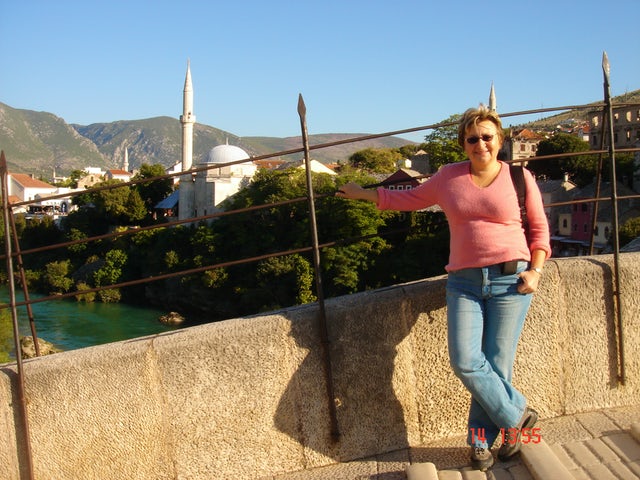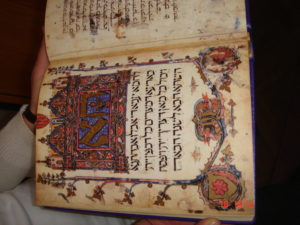 Sophia’s Travel AKA Jewish Travel Agency is proud to present our Bosnia Herzegovina Jewish Heritage tour with Croatia.
Sophia’s Travel AKA Jewish Travel Agency is proud to present our Bosnia Herzegovina Jewish Heritage tour with Croatia.
Day 1 Sarajevo
Transfer from Sarajevo airport to hotel – Depends on arrival short tour of Sarajevo downtown – Dinner – Overnight in Sarajevo
Day 2 Sarajevo
Breakfast – Visiting National Museum of Bosnia and Herzegovina and Haggadah (The Sarajevo Haggadah is a Hebrew illuminated manuscript Codex, which dates from medieval Spain. It is considered one of the finest books of this kind and kept at the National Museum in Sarajevo and its in it possession since 1894, while previously belonged to the Sarajevo Jewish family Kohen. The Sarajevo Haggadah, along with the Jews, left Spain in the 15th century, and there is evidence that even in 1609 was located in Italy. It was somewhere in northern Spain, in the second half of the 14th century.
The content of the Sarajevo Haggadah is written in the penmanship processed and an acute skin during the period when the paper has not yet entered into mass use. This exceptional manuscript has 142 parchments leaf size 16,5 x 22,8 cm. Some of them are written in penmanship, some illuminated, and some completely empty.
Wrapped in sheet of eight or twelve pages.) – Coffee break – Jewish Tour of Sarajevo – Visiting Bosnian Cultural Center which used to be biggest Sephardic synagogue in Balkans. – Lunch – Free time – Overnight in Sarajevo
 Day 3 Sarajevo
Day 3 Sarajevo
Breakfast – Visiting Jewish Museum of Bosnia and Herzegovina (It was built in 1580. when Rumeliya Bey Sijamus Pasha gave money to build a large residential facility for the Sephardic Jews, who were in 1566 expelled from Spain, arrived in Sarajevo, and they brought their customs and one of the most important manuscripts from the fifteenth century – the Sarajevo Haggadah. By the end of 16th century in the courtyard area of the Great Walkway was created the first Synagogue. The building was badly damaged by fire in 1697 and in 1788. After many difficulties and obtaining permission from Turkish authorities for renewal in 1794, the synagogue was rebuilt by 1821. The last prayer was heard in Synagogue six days after the April occupation of Sarajevo, in 1941.
During the Second World War, the synagogue was converted into a prison, and then in the warehouse. After restoration in 1966, Synagogue becomes the Jewish Museum of Bosnia and Herzegovina. Documents and objects in the museum bear witness to the life and creativity of the people who have a significant share of the total historical picture of this country.)
– Coffee in the Synagogue and meeting with the members of the Synagogue
Visiting Jewish cemetery (Jewish cemetery in Sarajevo is located in the southwestern part of the City, in an area of Kovačići and Large Hill. After Prague it is the largest Jewish religious complex, while one of the most valuable memorial complex in Europe. The entire complex covers an area of 31.160 m2. There is no reliable documentation about emergence and development of the cemetery until 16th century, but based on the data protocol of the Jewish community, 1630 can be taken as the year of establishment of this cemetery. The oldest preserved tombstone in this cemetery belongs to the first rabbi of Sarajevo. On the tombstones of his chest reads: “Baruch Samuel, 1630-1650 tombstone upright.” Beside him, under the 3850 monuments rests family: Abinun, Albahari, Altarac, Atijas, Baruch, Danita, Danon, Finns, Gaon, Kabiljo, Kajon, Calderon, Kamhi, Katan, Konforti, Kunorti, Levi, Maestro, Montiljo, Obadiah, Ozmo , Pardo, Passover, Pinto, Salom. And the biggest and toughest monument belongs to the late Samuel Pinto.)
Dinner enjoying Sephardic music preformed by ensemble Arkula from Mostar – Overnight in Sarajevo
Day 4 Sarajevo
Breakfast – Visiting the Synagogue – Center of Holocaust Education, presentation of project – Lunch – Presentation of B&H Jewish Community – Sabbath – joint dinner with the Community members – Overnight in Sarajevo
Day 5 Sarajevo
Breakfast – Grand tour of Sarajevo (Sarajevo city is famous for its traditional religious diversity, with adherents of Islam, Orthodoxy, Catholicism and Judaism coexisting there for centuries. Due to this long and rich history of religious diversity and coexistence Sarajevo has often been called the City where East meet West.) – Lunch and refreshment in Vrelo Bosne – Dinner – Overnight in Sarajevo
Day 6. Mostar
Free time until Sabbath ends – Departure to Mostar – Dinner – Overnight in Mostar
Day 7 Mostar
Breakfast – Tour of Mostar City (Perhaps most famous for its 16th century old bridge (Stari Most), Mostar is the cultural and political capital of Herzegovina. The heart of the old town, highlighted by the Stari Most and the turquoise Neretva River that flows below it, has been a magnet for tourists for many decades. This quaint Ottoman old quarter is a living tribute to the ingenuity and beauty of Ottoman architecture.)
– Departure to Stolac City (In Stolac is the tomb of Rabbi Moshe Danon, located on the way from Mostar to Stolac and each year in the month of June on day of 20 Sivan, Jewish Community in Sarajevo organizes a traditional pilgrimage. This pilgrimage is one of the most important legacies of the Bosnian Sephardic culture and tradition.)
– Drive and tour of historic city of Pocitelj (In the valley of Neretva, Pocitelj was the mainstay of the Turks. This fortress was built by King Tvrtko in 1383, and it had strategic role in controlling the way to the sea through the Neretva valley. In the middle ages, Pocitelj was the administrative centre and centre of governance of Dubrava zupa (county), and its westernmost point, which gave it major strategic importance. It is supposed that the fortified town and its attendant settlements were built by Bosnia’s King Stjepan Tvrtko I in 1383. The walled town of Pocitelj evolved over the period from the sixteenth to the eighteenth centuries. Architecturally, the surviving stone-built parts of the town are a fortified complex, in which two stages of evolution may be observed: mediaeval, and Ottoman. The first documented reference to the town dates from 1444, in Charters issued by Kings Alfonso V and Friedrich III. During the period 1463-1471 the town held a Hungarian garrison. Following a brief siege in 1471, the town fell to the Ottomans, and was to remain within the Ottoman Empire until 1878. From 1782 to 1879 it was the centre of a kadiluk (area under the jurisdiction of a kadija or qadi – judge) and from 1713 to 1835 it was the headquarters of the Počitelj military district. – Lunch at Buna river – Departure to Dubrovnik – Overnight in Dubrovnik.
Day 8 Dubrovnik
Breakfast
– Jewish tour of Dubrovnik including Synagogue (The Old Synagogue in Dubrovnik, Croatia is the oldest Sephardic synagogue still in use today in the world and the second oldest synagogue in Europe. It is said to have been established in 1352 , but gained legal status in the city in 1408. Owned by the local Jewish community, the main floor still functions as a place of worship for Holy days and special occasions, but is now mainly a city museum which hosts numerous Jewish ritual items and centuries-old artifacts.) – Dinner – Overnight in Dubrovnik
Day 9 Dubrovnik
Breakfast
– Grand tour of Dubrovnik (Dubrovnik is a Croatian city on the Adriatic Sea coast positioned at the terminal end of the Isthmus of Dubrovnik. It is one of the most prominent tourist destinations on the Adriatic, a seaport and the center of Dubrovnik-Neretva county. In 1979, the city of Dubrovnik joined the UNESCO list of World Heritage Sites. The prosperity of the city of Dubrovnik has always been based on maritime trade. In the Middle Ages, as the Republic of Ragusa, also known as Maritime Republic (together with Amalfi, Pisa, Genoa, Venice and other cities), it became the only eastern Adriatic city-state to rival Venice. Supported by its wealth and skilled diplomacy, the city achieved a remarkable level of development, particularly during the 15th and 16th centuries.) – Dinner – Overnight in Dubrovnik
Day 10 Sarajevo
After breakfast drive to Sarajevo
– Visiting Park of Nature Hutovo Blato including lunch (Hutovo Blato is a nature reserve and bird reserve located in South Bosnia and Herzegovina. It is primarily composed of marshlands that were created by the underground aquifer system of the Krupa River. It is fed from the limestone massif of Ostrvo that divides the Deransko lake and Svitavsko lake. The reserve is on the list of Bird Life International’s Important Bird Areas. It is the largest reserve of its kind in the region, in terms of both size and diversity. It is home to over 240 types of migratory birds and dozens that make their permanent home in the sub-Mediterranean wetlands surrounding Deransko Lake. In the migration season, tens of thousands of birds fill the lake and its surroundings.) – Dinner – Overnight in Sarajevo
Day 11- Sarajevo
Breakfast – Transfer from hotel to Airport
This is a suggested itinerary for individuals and groups and is customized for each client.